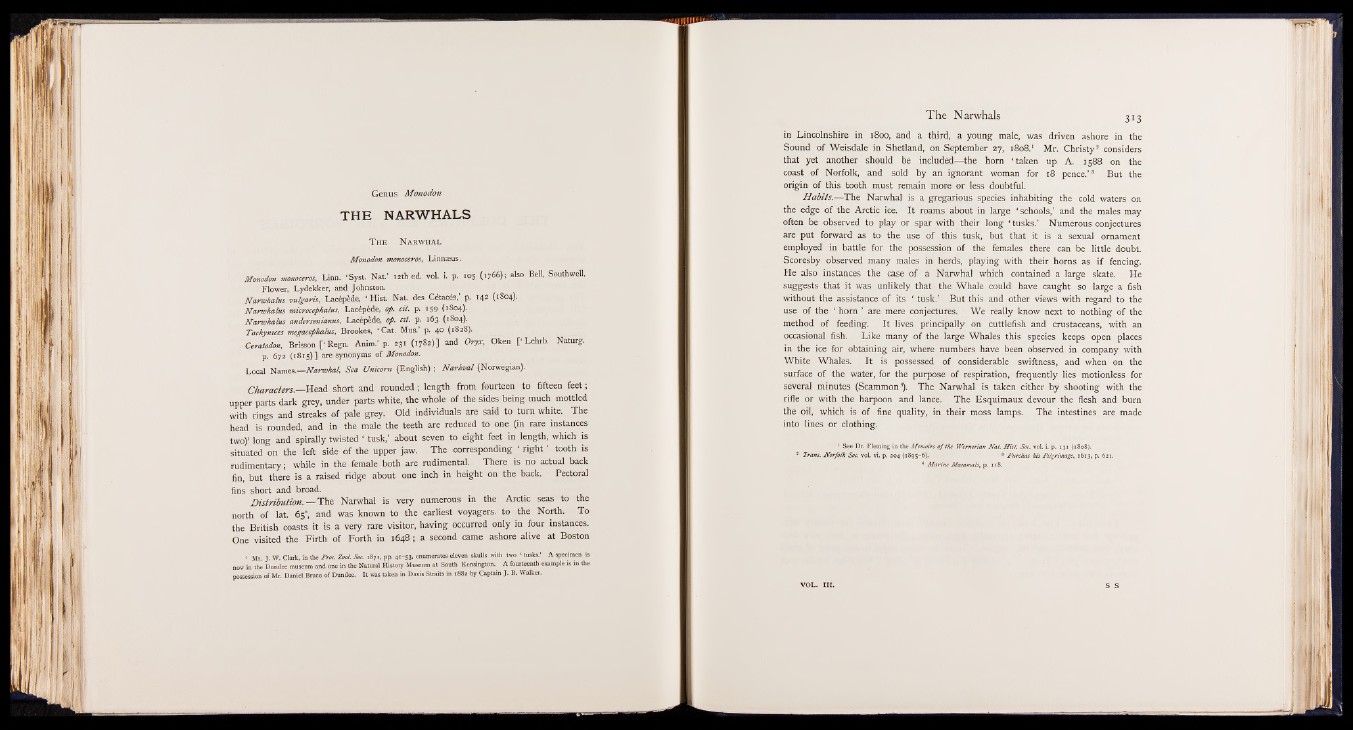
Genus Monodon
T H E N A RW H A L S
T h e N a r w h a l
Monodon monoceros, Linnaeus.
Monodon monoceros, Linn. ‘ Syst. Nat.’ I2th ed. voi. i. p% 0 5 (1766): also Bell, Southwell,
Flower, Lydekker, and Johnston.
Narw halus vulgaris, Lacépède, ‘ Hist. Nat. des Cétacés,’ p. 142 (1804).
Narw halus microcephalus, Lacépède, op. cit. p. 159 (1804).
N arw halus andersonianus, Lacépède, op. a t. p. 163 (1804).
Tachymces megacephalus, Brookes, ‘ Cat. Mus. p. 4° (1828).
Ceratodon, Brisson [ ‘ Regn. Anim.’ p. 231 (1782)] and Oryx, Oken [‘ Lehrb. Naturg.
p. 672 (1815)] are synonyms o f Monodon.
Local Names.— N arw hal, Sea Unicom (English) ; N a rh va l (Norwegian).
Characters.— Head short and rounded ; length from fourteen to fifteen feet ;
upper parts dark grey, under parts white, the whole of the sides being much mottled
with rings and streaks of pale grey. Old individuals are said to turn white. The
head is rounded, and in the male the teeth are reduced to one (in rare instances
two)1 long and spirally twisted ‘ tusk,’ about seven to eight feet in length, which is
situated on the left side of the upper jaw. The corresponding ‘ right ’ tooth is
rudimentary; while in the female both are rudimental. There is no actual back
fin, but there is a raised ridge about one inch in height on the back. Pectoral
fins short and broad.
Distribution. — The Narwhal is very numerous in the Arctic seas to the
north of lat. 65°, and was known to the earliest voyagers, to the North. To
the British coasts it is a very rare visitor, having occurred only in four instances.
One visited the Firth of Forth in 1648 ; a second came ashore alive at Boston
1 Mr. j. w. Clark, in the Proc. Zool. Soc. 1871, pp. 41- 53. enumerates eleven skulls with two ‘ tusks.’ A specimen is
now in the Dundee museum and one in the Natural History Museum at South Kensington. A fourteenth example is in the
possession of Mr. Daniel Bruce of Dundee. It was taken in Davis Straits in 1882 by Captain J. B. Walker.
in Lincolnshire in 1800, and a third, a young male, was driven ashore in the
Sound of Weisdale in Shetland, on September 27, 1808.1 Mr. Christy2 considers
that yet another should be included— the horn ‘ taken up A. 1588 on the
coast of Norfolk, and sold by an ignorant woman for 18 pence.’ 8 But the
origin of this tooth must remain more or less doubtful.
H abits.— The Narwhal is a gregarious species inhabiting the cold waters on
the edge of the Arctic ice. It roams about in large ‘ schools,’ and the males may
often be observed to play or spar with their long ‘ tusks.’ Numerous conjectures
are put forward as to the use of this tusk, but that it is a sexual ornament
employed in battle for the possession of the females there can be little doubt.
Scoresby observed many males in herds, playing with their horns as if fencing.
He also instances the case of a Narwhal which contained a large skate. He
suggests that it was unlikely that the Whale could have caught so large a fish
without the assistance of its ‘ tusk.’ But this and other views with regard to the
use of the ‘ horn ’ are mere conjectures. We really know next to nothing of the
method of feeding. It lives principally on cuttlefish and crustaceans, with an
occasional fish. Like many of the large Whales this species keeps open places
in the ice for obtaining air, where numbers have been observed in company with
White Whales. It is possessed of considerable swiftness, and when on the
surface of the water, for the purpose of respiration, frequently lies motionless for
several minutes (Scammon4). The Narwhal is taken either by shooting with the
rifle or with the harpoon and lance. The Esquimaux devour the flesh and burn
the oil, which is of fine quality, in their moss lamps. The intestines are made
into lines or clothing.
1 See Dr. Fleming in the Memoirs o f the Wernerian Nat. H ist. Soc. vol. i. p. 131 (1808).
3 Trans. Notfolk Soc. vol. vi. p. 204 (1895-6). 3 Purchas his Pilgrimage, 1613, p. 621.
* Marine Mammals, p. 118.
VOL. III. S S